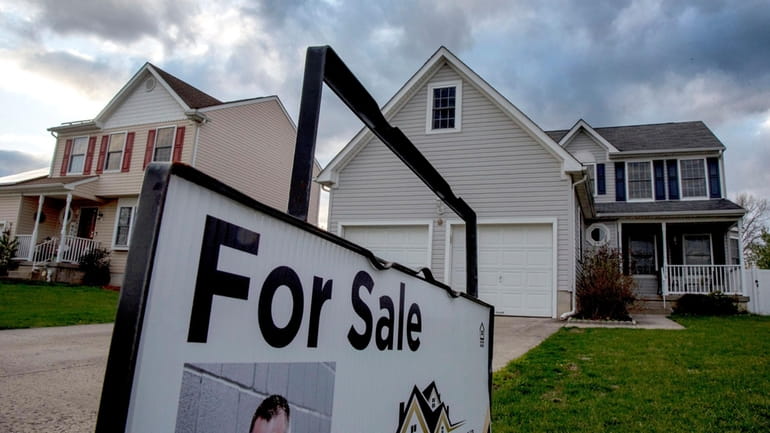More borrowers pay mortgage points, choose adjustable-rate mortgages

Adjustable rate mortgages are making a comeback as conventional rates rise. Credit: TNS/TOM GRALISH
Long Island homebuyers, who are already facing near-record home prices, have also been hit with higher financing costs. The surge has led an increasing number of U.S. homebuyers to purchase mortgage points — fees borrowers pay lenders to trim their rates— and use adjustable-rate mortgages to lower their monthly payments.
The average rate for a 30-year fixed home loan was 5.27% for the week ending May 5, according to mortgage giant Freddie Mac. That rate is the highest since August 2009.
The 30-year fixed rate has increased 2.3 percentage points from the same week a year ago, which makes it the fastest 12-month increase since 1981, Len Kiefer, deputy chief economist at Freddie Mac wrote Thursday.
Mortgage rates have risen during a period of high inflation. The Federal Reserve on Wednesday took its most aggressive action since 2000 to tame inflation, increasing its benchmark interest rate by a half-percentage point and indicating it would authorize several more increases this year. Mortgage rates are not tied directly to the Fed’s benchmark rate; they are more connected to the 10-year Treasury yield.
How consumer prices react to actions taken by the Federal Reserve could very well determine whether rates will rise further, said Odeta Kushi, deputy chief economist at First American Financial Corp., a provider of title insurance and settlement services, in Washington D.C.
“Whether the Federal Reserve can get inflation under control, I think that will really be a driver of mortgage rates going forward," she said. "If inflation worsens, the Fed may need to be even more aggressive, which may put further upward pressure on mortgage rates.”
In the meantime, a small, but growing, share of borrowers have turned to adjustable-rate mortgages. Those loans start with a fixed rate for a period of time, such as five or 10 years, but after that interest rates change a certain number of times per year based on market conditions. The latest average for a 5/1 adjustable-rate mortgage, which means the rate is fixed for five years and then can adjust once per year, was 3.96%, according to Freddie Mac. That’s 1.31 percentage points lower than the 30-year fixed average.
The share of adjustable-rate mortgages, or ARMs, as a percentage of all mortgage applications doubled in the past three months to 9.3% as rates climbed, according to the Mortgage Bankers Association.
On Long Island, adjustable-rate mortgages represented 10.7% of borrowers locking in their rates last month, the highest percentage since November 2018, and nearly four times the percentage choosing that option a year ago, according to Black Knight, a mortgage technology and data provider.
ARMs carry the risk of a considerable increase in monthly payments after the fixed-rate period ends, which played a role in the 2008 subprime mortgage crisis. Federal policymakers have sought to strengthen protections for borrowers since then, Kushi said.
ARMs can work well for some buyers, including investors and those who plan to move or refinance before the rate changes.
Andrew Russell, owner and founder of RCG Mortgage in Hauppauge, said he outlines the risks of ARMs carefully with borrowers, noting they might not be able to easily refinance in five years if home prices fall or they lose their job.
He asks whether the savings is "enough per month over the life of the first several years to warrant the stress levels you’re going to have or equity you will lose in closing costs when you do a refinance?”
As rates move daily, Russell advises buyers to check in frequently with their broker to make sure "you're not looking at houses you don't even qualify for anymore."
Points given and taken
Buying mortgage points is another way to lower homeowners’ monthly costs, and can be a better use of funds than adding to a down payment in some cases, said Steve Probst, branch manager at Fairway Independent Mortgage Corp. in Hauppauge. For a buyer of a $550,000 home, making a 20% down payment, and seeking a $440,000 mortgage, the buyer would stand to save more making a $10,000 investment in mortgage points than adding $10,000 to the down payment, Probst said.
Decreasing the size of the mortgage by $10,000 would save about $56 a month, while spending $10,000 to lower a fixed mortgage rate from 5.375% to 4.875% would save about $135 a month, he said. The borrower would recoup that investment in six years, not including potential tax relief, Probst noted.
“Paying points has its place today,” Probst said. "If you know you’re going to be long term in a property it may be very worthwhile to explore paying points instead of making a larger down payment.”
The average points paid on 30-year fixed loans increased to 0.9 compared with 0.6 points a year ago, according to Freddie Mac.
Kushi, of First American, said she anticipates home prices will rise at a slower rate over the next year than they have in the past, but she doesn’t believe there is a housing bubble that will lead home prices to fall. The combination of strong demand for housing, a limited supply of homes for sale and stricter lending standards all point to continued growth in home prices at a slower pace.
“A housing boom doesn’t necessarily imply a bust,” she said.

